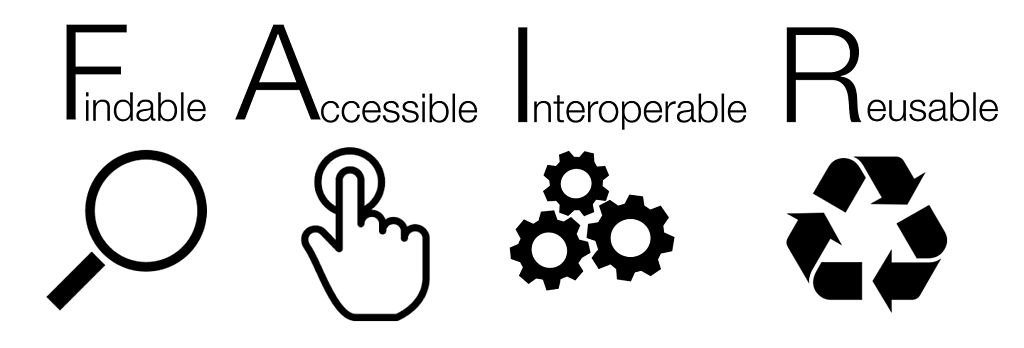Guidelines for FAIR data preparation and implementation

@ SangyaPundir, CC BY-SA 4.0, via Wikimedia Commons
The referenced FAIR Guiding Principles set the groundwork for making decisions on implementation but do not endorse any particular technology, standard, or method of implementation. Furthermore, these Principles are not a standard or specification in their own right. They serve as a navigational aid for data publishers and stewards, helping them assess if the choices they've made in implementing these principles effectively make their digital research assets Findable, Accessible, Interoperable, and Reusable.
The following considerations must be taken into account when preparing for implementation of each of the principles.
Findability
- The cornerstone of making data findable is assigning a globally unique and persistent identifier (PID) to each dataset and its metadata. This is crucial for the longevity of data accessibility, especially beyond the lifespan of the project or community. Utilizing third-party services like Digital Object Identifiers (DOIs) can ensure that data remains accessible and identifiable, even if its physical location changes. This also supports the accessibility principle by keeping the metadata discoverable even when the data is no longer available.
- Defining what constitutes "rich" metadata is a challenge that requires domain-specific knowledge. For radiological and clinical data, this might include details on imaging techniques, patient demographics, clinical outcomes, and biomarkers. The goal is to facilitate uniformity and harmony in metadata across datasets, making them easily findable and usable. Communities are encouraged to adopt machine-actionable metadata templates to standardize metadata capture, ensuring ongoing curation and updates.
- Linking datasets to their metadata clearly and explicitly is fundamental. Technologies like FAIR Data Points (FDP) leverage models such as DCAT to provide unique identifiers for metadata layers, guiding users seamlessly from metadata to the actual data. This ensures that users can find detailed information about the data, enhancing its findability and usability.
- Navigating the complexities of data indexing is vital for making radiological data findable. The heterogeneity of search tools and restrictions on automated searches pose significant challenges. Projects should choose search engines that align with their metadata standards and provide a machine-readable interface for automated searches. There is, however, a pressing need for domain-specific search strategies that cater to the unique aspects of biomedical data.
Accessibility
- Data and metadata should be retrievable through widely accepted, open protocols like HTTP, ensuring they can be accessed easily without specialized tools.
- It's vital to document any access restrictions clearly within the metadata to maintain transparency. For instance, if accessing a dataset of MRI images requires specific authorization due to patient privacy concerns, this procedure should be clearly outlined and standardized as much as possible to facilitate access while ensuring data protection.
- Communities face the task of establishing policies for metadata persistence to ensure the metadata remains accessible even when the data does not. This involves creating actionable templates for these policies and devising a scheme to link to these policies effectively. Early initiatives to tackle this issue draw on digital curation principles and the development of FAIR-compliant Data Management Plans (DMPs), among other strategies aimed at enhancing the long-term management of reusable digital resources.
Interoperability
- A crucial aspect to consider is that the FAIR principles aim to facilitate data reuse by any user, not just those within a specific community.
- Achieving this broad accessibility often requires presenting information in widely recognized formats, even if it leads to duplicating data already available in formats specific to certain communities.
- Adopting a universally understandable language for data representation, such as RDF, enables datasets to be easily integrated and understood across different systems.
- Utilizing vocabularies that adhere to FAIR principles enhances this further by ensuring that terms used within the data are globally recognized and interpretable. The adoption of standard terminologies such as RadLex (for medical imaging concepts), SNOMED CT (for general clinical concepts) and ICD (for medical diagnosis) ensures that datasets can be seamlessly combined and used in diverse research contexts, enhancing their value.
Reusability
- A present challenge lies in the lack of clear distinctions between licenses for data and those for metadata, creating ambiguity in license interpretation within metadata records. Communities are tasked with selecting appropriate licenses for both data and metadata, ensuring they facilitate not just immediate use but also broader, future applications.
- Communities are encouraged to select metadata descriptions that enhance both machine and human reusability, focusing on the detailed provenance to significantly impact data reuse. This approach aligns with the principles of detailed metadata provision, emphasizing reuse over mere findability. Utilizing templates like PROV-Template simplifies capturing provenance by structuring information collection in advance, making it easier for community members without deep knowledge of complex ontologies. Tools such as CEDAR, CASTOR, and the Data Stewardship Wizard are being developed to facilitate the creation of FAIR-compliant metadata, leveraging structured models over simple vocabularies for clarity and consistency in data description.
- Communities need to select data and metadata practices that align with cross-domain interoperability needs. This involves determining which local metadata standards should also conform to broader, global standards to ensure wider usability, even at the risk of duplicating metadata. This strategy aims to make data more accessible and interpretable by a wider range of users and systems.

